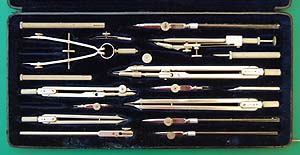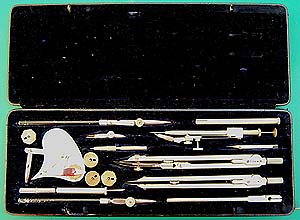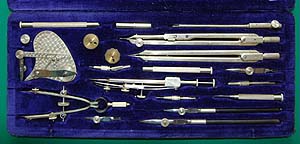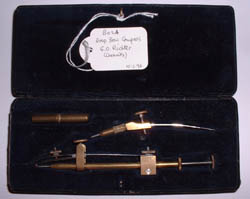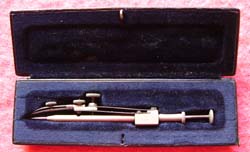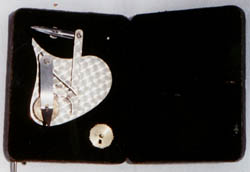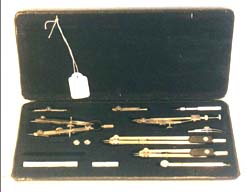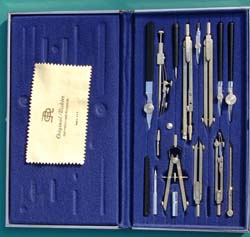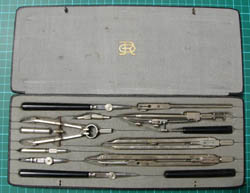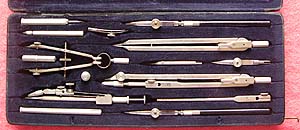












E O Richter (c1841-1907) founded the firm in Chemnitz, Saxony, after training as a clockmaker. In 1892 he patented his “flat system”, copied by many other makers after his patent ran out in 1905. Firm became a VEB Kombinat (i.e. a state owned company) in 1945. Richter instruments continued to be made in the DDR until the 1980s at least.
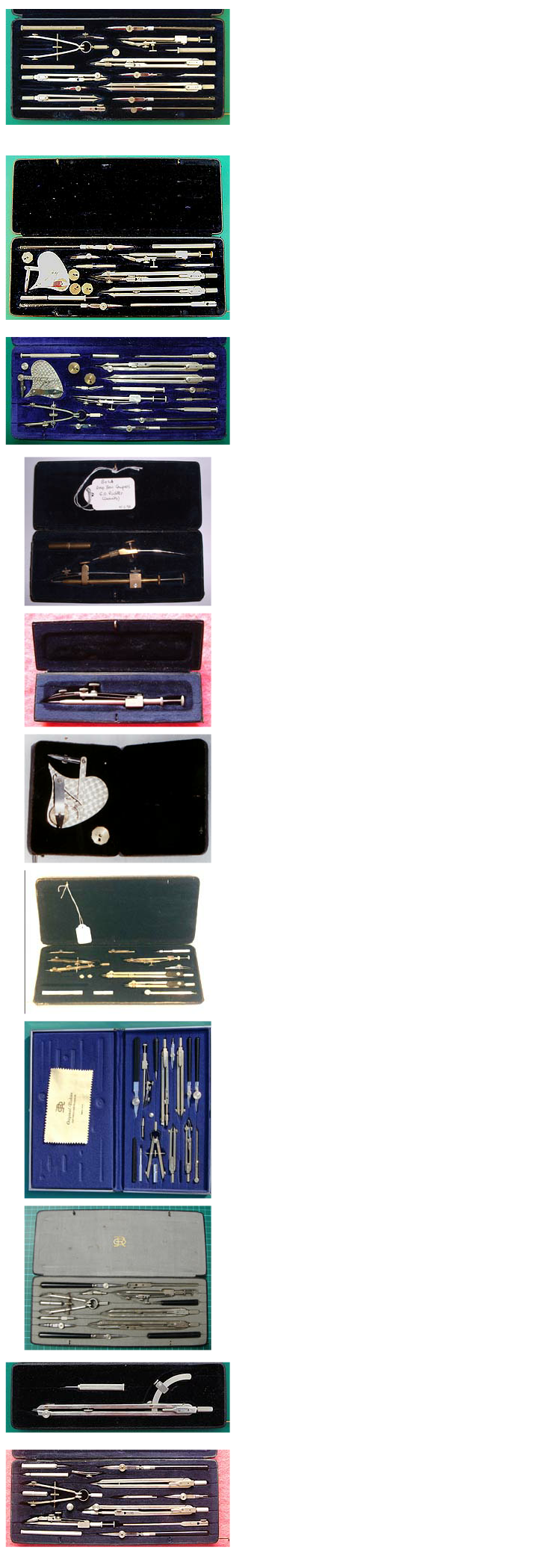
A German silver flat pattern set, each instrument signed Richter with (mostly) DRP and the E O Richter monogram trade mark as well. The black leather covered case, blue velvet lined, has A G Thornton Ltd, Manchester on it. The Thornton Minerva series, introduced by 1916, were close copies of these Richter instruments, although the spring bow and pen designs were changed quite early in production (by 1922 or possibly earlier). This set dates from before the first world war.
This E O Richter Präcision set also probably dates from before WW I. Made of German silver, it has a leather covered case. The pens are of the cross joint type and have aluminium handles. The compass and divider have Richter’s patent straightening device that was later copied by Thornton
Präcision XIV.P German silver flat pattern set in a black covered, blue velvet lined pocket case. The instruments themselves are unsigned but very similar to those by Richter. Its seller believed it dated from before the first world war but some features of the instruments look c1930 or later. Does anyone have more information?
A brass and steel rotating (drop bow) compass by E O Richter dating from about 1900. This is an early version with pen and pencil legs, each with its own single leaf spring.
‘Industrie’ series.
A later, E O Richter, nickel silver drop bow compass. This is of the twin leaf design which had the advantage of keeping the pen at the same angle to the paper irrespective of how far the compass was opened.
A dotted line pen, originally patented by Richter; unsigned copy made after the patent expired
An "Original Richter K9B H" set which probably dates from the 1960s/1970s. It was made in East Germany
Another "Original Richter" set, made in the DDR (East Germany), possibly in the 1970s. The black leather covered case is edged with steel and lined with blue felt.
An E O Richter Präcision no. 1836 set. This set contains the flat system instruments patented by Richter in 1892 and widely copied by makers such as A G Thornton once the patent expired. The pen handles are black plastic, possibly Bakelite. The case is covered in black leathercloth and lined in gray silk and cloth.
E O Richter Präcision ‘planimeterzirkel’ (Q244). A special type of divider for evaluating the area of an engine indicator diagram for which instructions are given in the 1928 catalogue.
Wichmann Reisszeug no. 945 nickel silver set dating from 1946. Most of these instruments are identical to those in the Richter set above, although they are stamped Wichmann. Although Wichmann may have made some of the instruments they sold it is known that they bought many items in, which were branded Wichmann. I think it possible that these were made by Richter. The case is covered in black leathercloth and lined with blue velvet.

This E O Richter Präcision VI P set dates from about 1900. The leather case with a silk lined lid and ribbon edging is an early feature as is the needle mount on the compass. The drop bow is the design superseded by a new one patented in 1904. Pencil points to both compasses and a screwdriver are missing and the case is rather distressed - the set was purchased to provide spares for other sets.





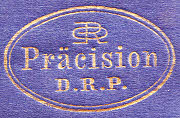
This larger Richter set dates from the same period as the one above.
This XVI P set by E O Richter dates from the 1920s. These later cases have curved corners and the lid is domed. They no longer have locks and many of the instruments differ in detail from the ca.1900 ones in the XV P set above.
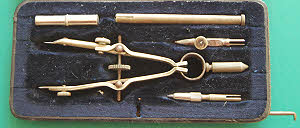
Richter spring bow set, ca.1900
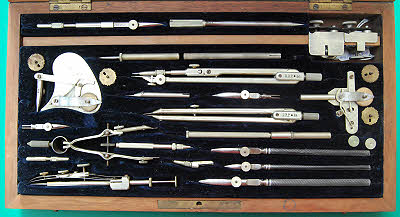
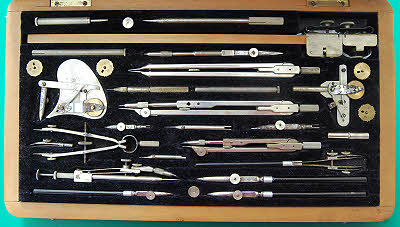
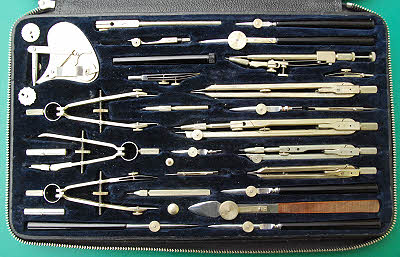
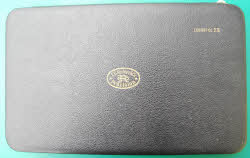
E O Richter Präcision Leonardo XII set in a zip fastened case.
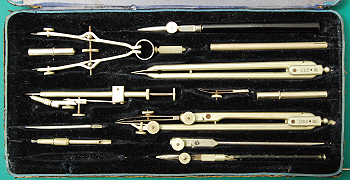
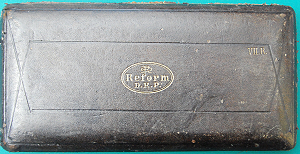
Richter “Reform VII R” set in a leather covered, blue silk & velvet lined, pin lock
case. It dates from the very early 1900s. The Reform series of instruments were cheaper
than the Präcision series but better quality than the Industrie series. Note the
unusual compass and divider heads with a ball instead of a handle.
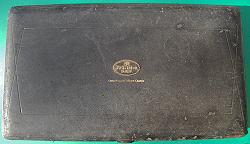
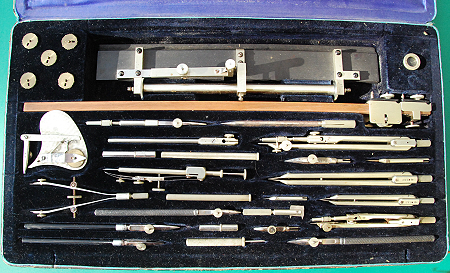
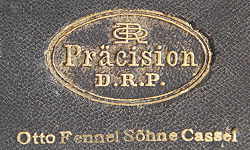
Large E O Richter Präcision set in a leather covered case dating from the 1890s.
When I received this set it had a number of issues. The most obvious one is the later
pattern small compass. The two shiny black handled pens are also later replacements
with cross-joint nibs. Many items were not in the correct slots and there were some
spurious ones such as a second lengthening bar that I have now removed. This left
two unfilled pen slots to which I have added two of the correct pens from a donor
set bought for spares some years ago. It is unusual to find a set this size that
is not in a polished wood case. Otto Fennel Sőhne (Otto Fennel Sons) of Kassel were
probably the retailers. The information below was provided by Georges Tock:
After some years of apprenticeship in the workshop of Breithaupt & Herschel, makers
of optical and surveying instruments, also in Kassel, the father Otto Fennel (1826
- 1891) founded his own workshop in 1851, in Kassel. From the beginning he specialised
in the construction of high quality surveying instruments, a production that was
continued by his sons and stayed in family ownership until about 1968. All "Fennel"
punched surveying instruments have a very high level of quality and precision





